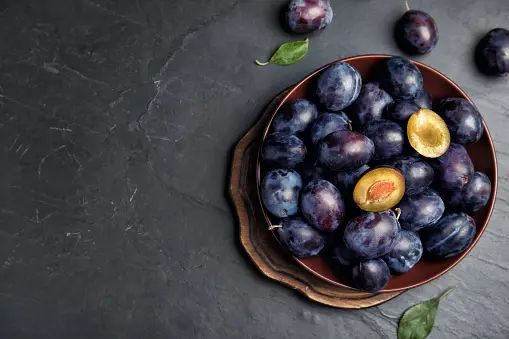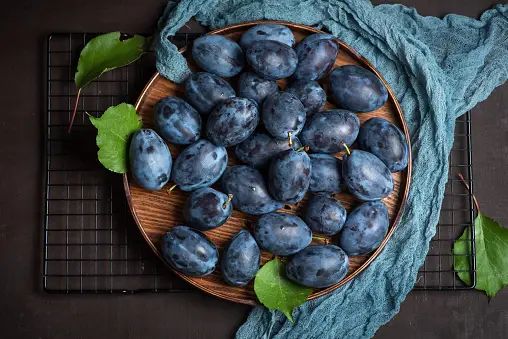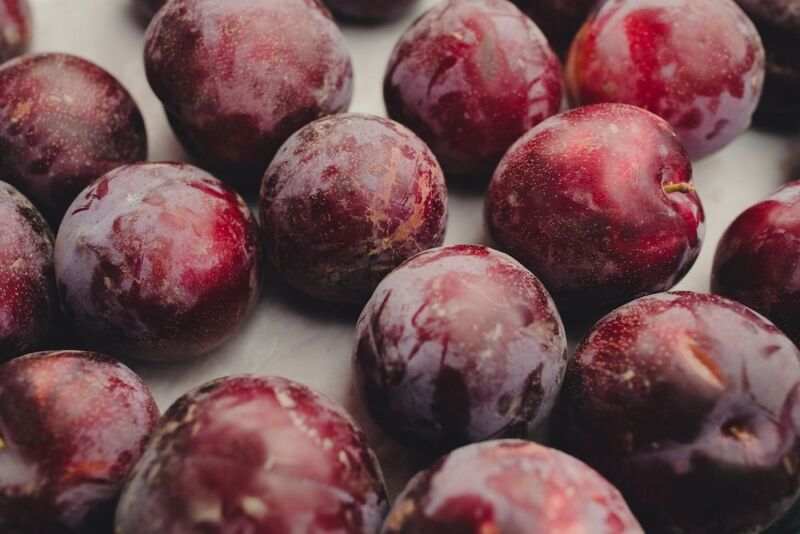Can You Freeze Plums?
Plums are a delicious stone fruit that hits its peak ripeness in the summer months. With their soft juicy flesh and sweet-tart flavor, plums are a tasty addition to everything from salads to desserts. However, plums are highly perishable due to their thin skins and high water content. They tend to spoil within a few days if left at room temperature.
Freezing is an excellent way to preserve fresh plums for later use. Properly frozen plums can maintain their texture and flavor for up to six months. This allows you to enjoy plum pie or jam during the off-season winter months. Here is a comprehensive guide on how to freeze plums to maximize their shelf life.
What are Plums?
Plums belong to the genus Prunus and are classified as stone fruit or drupes. There are many varieties of plums that come in diverse shapes, sizes, colors and flavors. The most common types of plums include:
- European plums – small and oval shaped with blue-black skins
- Japanese plums – larger, juicier and sweeter
- American hybrid plums – firm flesh and sweet flavor
- Damson plums – small, tart plums used for jams and jellies
Plums can range in color from yellow, green, red, purple, indigo and nearly black when ripe. The flesh inside can be firm and juicy. They contain a large, hard pit in the center which houses the seed.
Why Freeze Plums?

Fresh plums are highly perishable and have a short shelf life. Some reasons you may want to freeze plums include:
- Preserve the harvest – Freezing plums allows you to stock up during plum season and enjoy them year round.
- Maintain texture and flavor – Properly frozen plums retain their fresh, juicy texture and sweet-tart taste.
- Reduce food waste – Freezing stops spoilage so you don’t have to throw out overripe plums.
- Enjoy out of season – Frozen plums let you bake plum pies, crisps and other treats during the winter.
- Prepare ingredients ahead – Freeze plums to always have ingredients on hand for smoothies, jams, compotes etc.
Shelf Life of Fresh Plums
Fresh plums have a notoriously short shelf life compared to other fruits. Fully ripe plums last only 2-3 days at room temperature before spoiling. Once plums are picked, their quality quickly deteriorates.
Refrigerating plums helps extend their shelf life slightly. But even then properly stored plums typically last only 5-7 days in the fridge.
To maximize freshness, store ripe plums in the refrigerator in a permeable bag. Keep them away from ethylene producing fruits like apples which hasten ripening. Eat plums as soon as possible for the best texture and flavor.
Can You Freeze Plums Without Blanching?
Blanching is a process of briefly boiling then ice bath cooling fruits and vegetables before freezing. It helps deactivate enzymes that cause loss of flavor, color and texture during frozen storage.
For plums, blanching is optional but recommended. Plums contain enzymes that break down pectin in their cell walls over time. This causes frozen plums to become mushy and slimy upon thawing.
However, you can freeze plums without blanching. While it may sacrifice some texture, unblanched plums are still fine for cooking applications like baking, jams or sauces.
To blanch or not to blanch?
Here are some pros and cons of blanching plums before freezing:
Pros
- Maintains firm texture – Plums stay crisp instead of becoming mushy.
- Retains shape – Blanching prevents plums from leaking juices and falling apart.
- Holds color – Bright purple skin and flesh color is preserved.
- Stops enzymatic action – Pectin and nutrients don’t break down as much.
Cons
Added time and effort – Blanching adds multiple steps to the freezing process.
Nutrient loss – Some water soluble vitamins like vitamin C leach out during blanching.
Wet plums – Blanching introduces extra moisture which may cause ice crystals.
Overall, blanching is recommended for freezing plums you want to enjoy raw. But it can be skipped if freezing plums for cooking purposes.
Should You Freeze Plums with the Pits?

Plums contain a large, stiff pit at their center which houses the seed. The question is – should you freeze plums whole with pits, or is it better to pit them first?
Freezing plums whole with pits is simpler since it avoids the step of cutting and pitting. However, whole frozen plums with pits make storage and thawing inconvenient.
On the other hand, pitting plums before freezing has several advantages:
- Compact storage – Pitted plums pack together tightly without gaps.
- Even thawing – Pitted plums thaw at the same rate instead of around the pit.
- Easy to use – No need to pit thawed plums before eating or cooking.
- Accurate counts – Know exactly how many plum halves or slices you have.
Overall, pitting plums prior to freezing makes later use much easier. The extra time is worth it for the organizational benefits.
Can You Freeze Unripe Plums?
Freezing unripe plums is not recommended. Plums are a climacteric fruit, meaning they continue ripening after being picked from the tree.
Freezing interrupts the natural ripening process. Immature plums lack developed sugar content and flavor. If frozen unripe, they will never achieve optimal sweetness and taste.
For best results, only freeze tree-ripened plums at the peak of maturity. Look for plump plums that yield slightly to gentle pressure but still have firm flesh.
The fruits should have rich, deep coloration and sweet fruity aroma. Their stems should detach easily from the branch when ready to harvest.
Ripe plums stopped just short of overripe have the best flavor to freeze. Let any greenish plums fully ripen on the counter before freezing them.
How to Store Fresh Plums in the Fridge
Proper storage extends the shelf life of fresh plums to eat now. Follow these tips for keeping plums in the refrigerator:
- Leave stems on – Keep stems attached until ready to eat to prevent moisture loss.
- Don’t wash – Washing removes natural protective coating and introduces water.
- Seal in container – Store in an airtight plastic container or bag.
- Avoid cold air – Position plums away from vents releasing cold air.
- Watch for mold – Check periodically and remove any spoiled plums.
Refrigerating ripe plums promptly in a covered container can prolong their edible window to around 5-7 days. Adjust humidity and temperature of produce drawers for best results.
Equipment Needed to Freeze Plums
Freezing plums at home doesn’t require any special equipment. Here are the basic supplies you’ll need:
- Paring knife – For pitting and slicing plums.
- Cutting board
- Large pot – If blanching.
- Slotted spoon – To transfer plums.
- Ice bath – Bowl of ice water for cooling blanched plums.
- Paper towels – For drying plums.
- Baking sheet – Line with parchment paper.
- Freezer bags – Quart or gallon size with zipper seal.
- Permanent marker – Label bags with contents and date.
Optional items if not blanching plums:
- Plum pitter – Makes removing pits easier.
- Mandoline – For quick, uniform plum slices.
Make sure all equipment is clean before getting started. Have freezer bags ready for filling.
Steps to Freeze Plums
Follow these simple steps for freezing plums at peak freshness:
1. Wash and Dry
Rinse fresh plums under cool water to remove any dirt or residue. Pat dry thoroughly with paper towels.
2. Pit and Slice
Cut plums in half lengthwise and remove the pit. You can leave slices intact or cut them into smaller pieces if desired.
3. Blanch (Optional)
For firmer texture, blanch plum halves for 1 minute in boiling water, then immerse in ice bath for 1 minute to stop cooking.
4. Arrange on Baking Sheet
Line a baking sheet with parchment paper. Arrange plum halves or slices in a single layer without touching.
5. Freeze
Freeze plums on uncovered baking sheets for 1-2 hours until solidly frozen. Transfer frozen plums to zipper freezer bags.
6. Squeeze Out Air
Remove excess air from bags before sealing to prevent freezer burn. Label bags.
7. Return to Freezer
Lay bags flat in coldest part of freezer. For best quality, use frozen plums within 6 months.
And that’s it! With these simple steps, you’ll have delicious frozen plums to enjoy any time.
How Long Do Frozen Plums Last?

Properly frozen plums maintain excellent quality for 6-8 months in the freezer. Their firm texture and sweet flavor remains intact.
After 8 months, frozen plums will still be safe to eat but may suffer some degradation. Quality declines with longer frozen storage.
To maximize shelf life:
- Use high quality ripe plums.
- Blanch for firmer texture.
- Package plums airtight in freezer bags.
- Press out air and seal bags tightly.
- Freeze plums as soon as possible after picking.
Avoid freezer burn by checking periodically for ice crystals or discoloration. Defrost only as much as you plan to use to retain texture and flavor.
Tips for Freezing Plums
Follow these best practices for successfully freezing summer plums:
- Pick ripe fruit – Only freeze tree-ripened plums at their peak.
- Work quickly – Freeze plums ASAP after harvesting to lock in freshness.
- Wash and dry thoroughly – Moisture leads to ice crystals and spoilage.
- Blanch for maximum firmness (optional) – Helps retain texture, shape and nutrients.
- Don’t crowd slices – Freeze in a single layer on sheets before transferring to bags.
- Remove air – Exclude oxygen by pressing bags to minimize freezer burn.
- Use freezer-safe packaging – Choose high quality bags designed for freezing.
- Label bags – Identify contents and date to track shelf life.
- Freeze promptly – Get plums from harvest into the freezer quickly.
- Organize upright – Stand bags upright to keep shape frozen.
Following proper plum freezing techniques will reward you with fresh-tasting fruit long after the season has ended!
How to Use Frozen Plums
Frozen plums are incredibly versatile in both sweet and savory recipes. Here are some delicious ways to use them:
- Smoothies – Add to fruit smoothies for thickness and sweetness.
- Yogurt – Mix into yogurt parfaits or overnight oats.
- Baking – Use in muffins, cakes, crumbles, galettes, or pies.
- Jams and chutney -Cook into plum preserves.
- Sauces – Puree into a sweet plum sauce for meats.
- Compotes – Simmer into a plum compote topping.
- Salads – Toss into spinach and goat cheese salads.
- Meats – Make a glaze for chicken, pork or salmon.
Let frozen plums thaw in the refrigerator before adding to recipes. They can be thawed quickly at room temperature or in the microwave.
Conclusion
Freezing is an easy, cost-effective way to enjoy fresh plum flavor year-round. Select ripe, undamaged plums and freeze them as soon as possible after picking. Blanching plums before freezing is optional but helps maintain firm texture.
Package plum halves or slices in a single layer on baking sheets before transferring to airtight freezer bags. Exclude excess air and label. Store bags flat to retain shape.
Properly frozen plums keep for 6-8 months. Their sweet flavor and vibrant color make them ideal additions to both sweet and savory dishes. Freezing lets you savor summer’s bounty of plums anytime.
